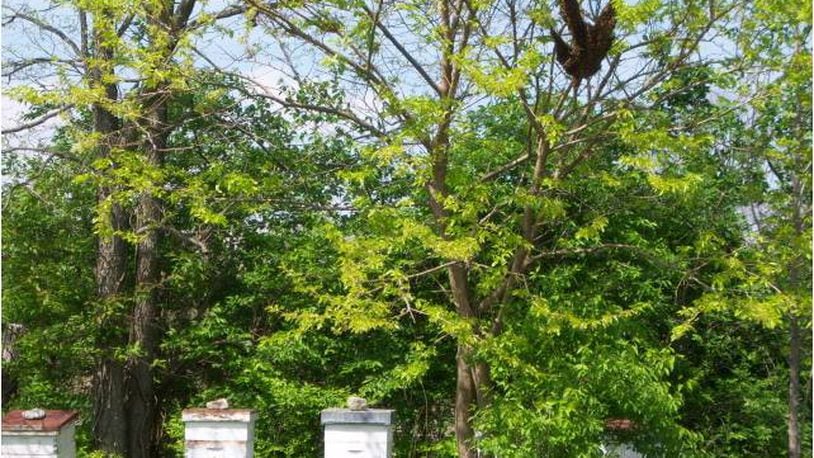So when colony growth is booming, the bees begin to plan their escape.
A new queen bee is raised to take over the hive, and the old queen takes off with a few thousand worker bees to find a new place.
First thing the old queen does is send out searcher bees to find a new home for the colony. While they search, the queen will hang out with her thousands of daughters. (All the worker bees are female and all the offspring of the queen.)
They form a big clump around the queen and attach to tree branches, fence posts or any fixed structure where they can wait for directions from the scouts. They can stay there for a few minutes or a few hours until moving on.
So what should we do when a loudly humming giant clump of bees affixes itself to something in our yard or farm?
I asked Medway resident Alec Ashbaugh what he would recommend.
Ashbaugh is the newest Bethel Township trustee and has been a beekeeper for 20 years.
“Keep your distance,” he said. “If you see a swarm, don’t worry they aren’t going to hurt you.”
Ashbaugh referred to the swarm as “happy house hunters.”
Of course, it is always wise to bring pets and children inside while a swarm is hanging out. Pestering or poking a swarm out of curiosity can cause them to get angry. And you do not want them to be angry.
Ashbaugh told me that beekeepers love to capture a swarm of bees. A healthy queen and thousands of worker bees can be relocated into a stack of wooden bee supers and become a vital part of a beekeeper’s yard.
Every year beekeepers need to replace the colonies that died off during the winter for a number of reasons. Capturing runaway swarms from healthy spring colonies is the least expensive way for beekeepers to expand the size of their bee yards.
“We lost all but two hives last year,” said Ashbaugh, who has been able to catch five swarms so far this year.
Today’s beekeepers, like Ashbaugh, have new “homes” awaiting swarms. He prepares stacks of wooden boxes called supers. Most bee keepers paint these white. Supers have internal frames of pre-formed honey comb that will help the traveling swarm to create orderly comb.
Ashbaugh is hoping to adopt more swarms this spring. “I keep everything I need in the trunk of my car, prepped and ready.”
Soon after relocation, worker bees will begin to gather pollen and increase the yield of gardens, orchards and fields. They will also make honey.
To keep the bees from swarming again, the beekeeper will add an extra “box” to the top of the stack of supers. It’s kind of like adding another floor to their house.
Since ordering new bees from a supplier is quite expensive, beekeepers prefer relocated swarms that adapt more easily. Adopting a swarm is a big win for the beekeeper and the neighborhood.
If left to their own resources, bees might end up in the walls of houses, in grills, hollow trees or other places where they cause problems. If they don’t find a home, they will die.
Removing bees out of the wall of a house is expensive since walls have to be cut into to locate the colony. Most beekeepers won’t remove bees from a house, according to Ashbaugh.
One of the beekeepers jobs over the summer is protecting the hive from dangers such as pesticide and herbicides.
Farmers are supposed to spray on days when the air is still so that the pesticide or herbicide settles down upon the crop. But if the wind is blowing or if the farmer drives so fast he creates a swirl behind him, the deadly mist can travel to areas where the bees pollinate or to the hives themselves.
It is disheartening for a beekeeper to spend a lot of time and effort maintaining equipment, rehoming swarms or buying new bees, only to see them all killed by careless spraying.
Ashbaugh said that people need to support bees, butterflies and other pollinators. Letting dandelions bloom, and planting wild flowers will support the local bees.
People who see a swarm attached to something should report it to local law enforcement or agriculture extension office, which has a list of beekeepers willing to come out to capture it.
About the Author
